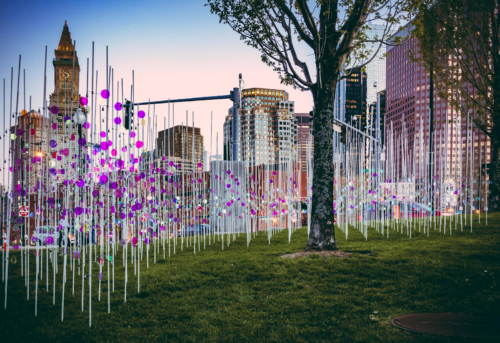Figure 1. Inspired by Boston’s marshy landscape, artist Carlona Aragon constructed High Tide, an art installation that vividly portrays the projected flooding caused by sea level rise. High Tide is composed of color-changing circles around vertical rods that visualize future flood levels. Image courtesy of Carlona Aragon and Matt Conti.
Art is a potent tool for communication and understanding: two ingredients crucial for spurring action. As the climate crisis continues to unfold—manifesting in catastrophic consequences such as sea level rise, wildfires, and disproportionate effects on marginalized communities—the need to engage with climate change’s human dimensions has become increasingly urgent. The Art x Climate project is an initiative that aims to incorporate visual art into discussions about climate change. Inviting artists to express their take on climate change, Art x Climate is the first interdisciplinary project of its kind to bridge the gap between quantitative analysis and the human experience of climate change.
Allyza Lustig MEM ’17, a senior manager at the US Global Change Research Program, has been at the forefront of integrating art into the discourse on climate change. She obtained her master’s degree at the Yale School of Forestry, studying the relationship between humans and the natural world through law, environment, and religion. With an informal interest in visual art ever since she was young, Lustig’s mission to incorporate the visual arts into climate assessment reports was motivated by an appreciation of art as a window into the perspectives and emotions of others.
“There’s a part of me that really appreciates the technical, structured, and quantitative ways of looking at the world, and then there’s the part of me that is also much more interested in relationships, emotions, and communicating,” Lustig said. “I think that this project really allowed me to bridge those worlds.”
For the fifth National Climate Assessment published in November 2023, Lustig spearheaded the Art x Climate Project, an initiative that called for visual art submissions across the US to be featured alongside traditional scientific assessments of climate change. Since climate change affects audiences from diverse backgrounds and demographics, one crucial consideration of the project was to ensure that it was inclusive of all perspectives. Lustig therefore opened submissions to both youth and adults and featured art exploring a variety of themes. The winning pieces of artwork delved into themes including the effect of climate change on endangered species, the impact of human-caused natural disasters on marginalized communities worldwide, and actions we can take to solve the climate crisis, such as the use of alternatives to fossil fuels.
Lustig received over eight hundred submissions and enlisted the expertise of eight jurors with backgrounds in both art and climate science to assist in the selection process. After careful consideration, ninety-two winners were chosen. The artists used a wide range of media to represent the causes and impacts of climate change. A 3D fiberglass installation designed by winning artist Carlona Aragon gives viewers the ability to visualize projected sea level rise, and Jillian Pelto’s piece combining watercolor, pencil, and line graphs meshes statistics and the natural beauty of the Gulf of Maine to call for urgent action. Pelto is a Washington-based artist and scientist known for incorporating environmental data into her art. Her piece demonstrates increases in climate change-related activity along three axes: the projected rise in sea level, the expansion of land protected by the National Wildlife Refuge, and the increase in the percentage of US adults supporting environmental protection policies. Other winning entries included Tammy West’s site-specific piece, Keep It Together, which features a red thread crisscrossing along a deep fissure in the earth, mimicking surgical sutures. Through direct engagement with the land, West intends to shed light on climate change-induced severe drought conditions in Texas. These works were interspersed within the report and published in a separate online gallery available for public viewing. “Art is a really powerful way to get people to understand, internalize, and connect with the issue of climate change,” Lustig said.
Lustig emphasized that science and art provide frameworks for understanding climate change but do so through different means. By embracing both disciplines and understanding them as distinct yet complementary tools for documentation, interpretation, and communication, Lustig believes we can deepen public engagement with the issue of climate change. “Art invites you in,” Lustig said. “It increases accessibility and engagement with the topic.”
In her final reflections on Art x Climate, Lustig said that the experience served as a source of inspiration and affirmation of the power of interdisciplinary collaboration. She hopes to encourage others to embrace innovative approaches to addressing the urgent challenges of climate change.
“Art has a very important role in processing and internalizing the movement of culture and society, and internalizing the very human consequences of climate change. We need leadership across institutions to stand behind this process and to value art as a vehicle for change,” Lustig said.
Figure 2. This multimedia piece, entitled Replanting Resilience, combines watercolor, colored pencil, and graphical data to illustrate the intersection of human and environmental responses to climate adversity in the Gulf of Maine. Image courtesy of Jillian Pelto.
Pelto is a winning artist: jillpelto.com.
[Citation]
United States Global Climate Change Research Program 2023, November 14). Fifth national climate assessment art × climate gallery. Art x Climate Gallery. https://nca2023.globalchange.gov/art-climate/

